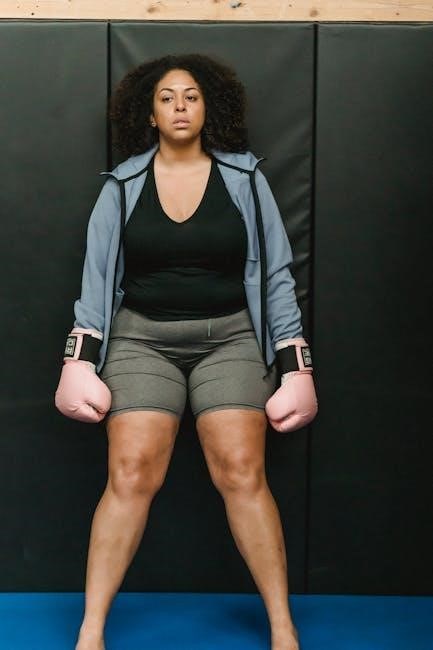glove size guide
Proper glove sizing is essential for comfort, performance, and protection. This guide helps you understand how to measure your hand, interpret size charts, and choose the perfect fit for any activity.
How to Measure Your Hand
To ensure an accurate fit, measure your hand carefully. Use a tape measure to wrap around the palm at the knuckles and align your hand with a size chart for precise sizing.
Tools Needed for Measurement
To accurately measure your hand for glove sizing, you’ll need a few simple tools. A soft, flexible tape measure is essential for wrapping around your palm. If you don’t have a tape measure, a piece of string and a ruler can work as alternatives. Print a glove size chart from a reliable source to compare your measurements. Ensure the chart is scaled correctly for accurate sizing. Place the chart on a flat surface and position your hand as instructed. A pencil or marker may be useful for marking measurements. Some guides recommend using a straight edge to align your hand properly. Having these tools ready will help you achieve precise measurements and ensure the best fit for your gloves.
Step-by-Step Guide to Measuring
Start by preparing your hand: remove any jewelry or tight clothing that could interfere with the measurement. Wrap a soft tape measure around the widest part of your palm, just below the knuckles, ensuring the tape is level and snug but not tight. If using a string, mark the point where it overlaps, then measure the length with a ruler. For hand length, measure from the base of the wrist to the tip of the middle finger. Compare these measurements to a glove size chart, ensuring alignment with the correct size. Some charts may require placing your hand on a printed guide and aligning fingers and palm for accurate sizing. Take your time to ensure precision, as proper fit is crucial for comfort and functionality. Repeat the process for both hands, as sizes may differ slightly.
Understanding Glove Size Charts
Glove size charts provide standardized measurements to help determine the best fit based on hand circumference and length. They vary by brand, ensuring accurate sizing for optimal comfort and performance.
Standard Glove Size Charts
Standard glove size charts are designed to provide a consistent reference for measuring hand size. These charts typically include measurements for hand circumference and hand length. Hand circumference is measured around the palm at the knuckles, excluding the thumb, while hand length is measured from the wrist to the tip of the middle finger. Most charts categorize sizes from small to extra-large, with specific measurements corresponding to each size. For example, a small glove might have a hand circumference of 7-7.5 inches, while an extra-large might be 9-9.5 inches. These charts serve as a universal guide, helping individuals select the right glove size for various activities. However, it’s important to note that sizing can vary slightly between brands, so referring to a specific brand’s size chart is recommended for the best fit.
Brand Variations in Sizing
While standard glove size charts provide a general guide, variations exist between brands due to differences in design, materials, and intended use. For instance, Hestra Gloves offers detailed size charts on their product pages, allowing customers to match their hand measurements precisely. Similarly, Foxgloves provides specific instructions for measuring hand circumference and length to ensure the best fit. Some brands, like RDX Products, include size charts for specific activities, such as boxing gloves, which may differ from general-purpose gloves. Additionally, certain brands cater to niche markets, like Protexgloves for individuals with skin conditions, offering tailored sizing. These variations highlight the importance of consulting the size chart provided by the brand when selecting gloves, as sizes may not be consistent across manufacturers. Always refer to the brand’s specific sizing guide to ensure the most accurate fit for your needs.

Factors Influencing Glove Fit
Glove fit is influenced by hand circumference, length, and activity-specific needs. Proper measurement ensures comfort, dexterity, and protection, crucial for optimal performance in various activities and conditions.
Hand Circumference and Its Impact
Hand circumference is a critical factor in determining glove size. It is measured by wrapping a tape measure around the palm, just below the knuckles, without including the thumb. This measurement ensures the glove fits snugly, providing optimal protection and dexterity. A proper fit prevents restrictive movement and discomfort, especially during activities requiring precision. If the circumference is too small, the glove may feel tight and hinder performance. Conversely, a circumference that’s too large can cause excessive material, reducing grip and control. Many brands use this measurement in their size charts, often categorizing sizes from small to extra-large based on specific circumference ranges. For instance, a circumference of 22 cm might correspond to a medium size, while 25 cm could be an extra-large. Understanding your hand circumference is the first step to selecting a glove that meets your needs. Proper sizing enhances both comfort and functionality, making it essential for any application, whether for sports, gardening, or professional use.
Hand Length and Its Significance
Hand length is another crucial measurement for determining glove size. It is typically measured from the base of the middle finger to the wrist crease. This measurement ensures the glove’s fingers are neither too short nor too long, providing optimal comfort and dexterity. A glove that fits well in length prevents restrictive movement and ensures proper coverage. Some size charts include hand length alongside circumference, offering a more precise fit. For example, a hand length of 17 cm might correspond to a small size, while 20 cm could indicate an extra-large. Measuring hand length accurately is essential for activities requiring precise finger movement, such as sports or precision work. It also helps in selecting gloves with activity-specific features, ensuring both comfort and functionality. Proper hand length ensures the glove’s fingers align naturally with your own, enhancing performance and protection. This measurement is vital for a glove that feels tailor-made for your hand.
Activity-Specific Considerations
Choosing gloves tailored to your activity ensures optimal performance and comfort. For sports like boxing or cycling, a snug fit is crucial for dexterity and control, while gardening or winter gloves may require a looser fit for layering. Measure hand length from the wrist crease to the middle finger for precise sizing. Consider materials suited to your activity—breathable fabrics for high-intensity sports and durable materials for heavy-duty tasks. Proper fit prevents blisters and enhances grip, ensuring safety and efficiency. Whether for precision work or casual use, selecting activity-specific gloves guarantees the best experience and protection. Always align your glove choice with your specific needs to maximize functionality and comfort.

Choosing the Right Glove Type
Selecting the right glove type ensures optimal fit and functionality. Consider your activity, hand size, and material preferences to enhance comfort, durability, and performance for your specific needs.
Activity-Specific Gloves
Choosing gloves tailored to your activity ensures optimal performance and comfort. For sports like boxing or biking, look for gloves with padding and grip. Gardening gloves should offer durability and water resistance, while medical gloves prioritize sterility and dexterity. Foxgloves Garden Gloves, for instance, are designed for protection and sensitivity, ideal for tasks requiring precision. Protexgloves cater to specific needs like skin conditions, offering comfort and protection. Consider the demands of your activity—whether it’s protection, flexibility, or breathability—and select gloves that align with these requirements. This ensures a balance between fit and functionality, enhancing your overall experience. Always refer to size charts specific to your activity to guarantee the perfect fit.
Material Considerations for Fit
The material of your gloves significantly impacts both comfort and fit. Leather gloves, for example, may stretch over time, providing a snug fit, while synthetic materials like nylon or polyester offer breathability and maintain their shape. Neoprene gloves are flexible and form-fitting, ideal for activities requiring dexterity. Consider the thickness and texture of the material, as these factors affect how the gloves conform to your hand. For instance, thicker materials may offer more protection but could restrict movement. Additionally, moisture-wicking fabrics are essential for activities that cause sweating, ensuring your hands remain dry and comfortable. When selecting gloves, prioritize materials that align with your activity’s demands, whether it’s durability, flexibility, or sensitivity. This ensures a balance between fit and functionality, enhancing your overall experience. Always refer to size charts specific to your activity to guarantee the perfect fit.

Common Mistakes to Avoid
When selecting gloves, several common mistakes can lead to an ill-fitting pair. First, many individuals fail to use a flexible tape measure, opting instead for rigid tools or guessing their size. Second, not accounting for hand length in addition to circumference is a frequent oversight. Third, assuming all brands use the same sizing standards can result in disappointment, as variations exist between manufacturers. Fourth, neglecting activity-specific requirements often leads to discomfort or inadequate protection. Finally, not considering material stretch or shrinkage, such as with leather, can compromise fit over time. To avoid these pitfalls, always measure carefully, consult brand-specific charts, and consider both function and material when choosing gloves. Proper attention to these details ensures a comfortable and functional fit tailored to your needs.

Ensuring the Perfect Fit
Achieving the perfect glove fit requires careful measurement and consideration of your hand’s unique dimensions. Always use a flexible tape measure to accurately assess your hand circumference and length. Place the tape around the widest part of your palm, just below the knuckles, and ensure it is snug but not tight. For optimal fit, consider both your hand’s circumference and length, as these measurements often determine size. Additionally, account for activity-specific needs, such as dexterity for work gloves or grip for sports gloves. If possible, try gloves on before purchasing, as materials like leather may stretch over time. Refer to brand-specific size charts, as sizing can vary between manufacturers. By combining precise measurements, activity requirements, and material considerations, you can ensure a glove that offers comfort, protection, and performance tailored to your needs.
Using Online Tools for Sizing
Online tools and resources make glove sizing more accessible and accurate. Many manufacturers, like Hestra Gloves, offer detailed size guides and printable charts on their websites. These tools allow you to measure your hand and match it to the perfect glove size. For example, Hestra provides a downloadable chart where you can place your hand to determine your size. Similarly, brands like Foxgloves offer step-by-step instructions for measuring hand circumference and length. Some websites even include interactive size calculators or videos to guide you through the process. By using these tools, you can minimize sizing errors and ensure a comfortable, precise fit. Always refer to the specific brand’s guide, as sizing can vary between manufacturers. Online tools are a convenient way to find your ideal glove size without the need for in-person measurements.

